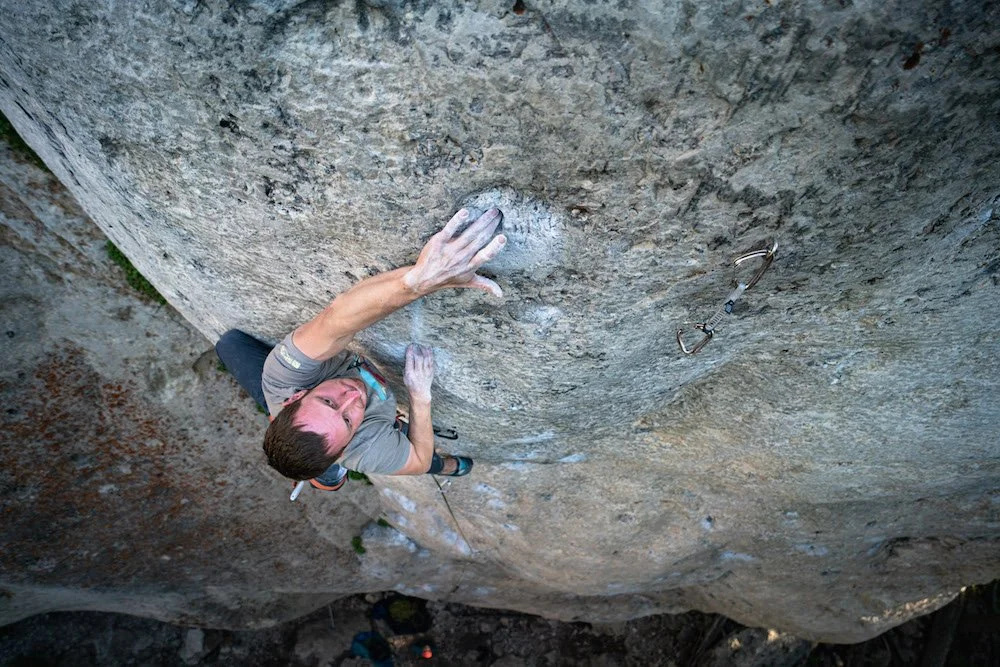Transitioning from Indoor to Outdoor Rock Climbing
Rock climbing is a thrilling and rewarding activity that challenges both the body and mind. Whether you're a seasoned indoor climber looking to venture into the great outdoors or a beginner eager to experience nature's vertical playground, transitioning from indoor to outdoor rock climbing requires careful preparation, skills acquisition, and an understanding of the unique challenges and rewards that outdoor climbing presents. In this guide, we'll explore the essential tips and skills you need to successfully make this transition.
Sport climbing in Wild Iris. Photo by Dalton Johnson
Pros
Natural Beauty: Outdoor climbing allows you to experience breathtaking natural landscapes and rock formations that indoor gyms cannot replicate.
Challenge and Variety: Outdoor routes offer a wide range of challenges, including different rock types, angles, and features, providing a more diverse climbing experience.
Adventure and Exploration: Climbing outdoors opens up opportunities for adventure and exploration as you discover new climbing areas and routes.
Skill Development: Transitioning to outdoor climbing helps develop essential skills such as route finding, anchor building, risk assessment, and climbing in diverse conditions.
Connection with Nature: Climbing outdoors allows you to connect with nature, appreciate the environment, and practice responsible outdoor ethics.
Community and Camaraderie: Outdoor climbing fosters a sense of community and camaraderie among climbers, encouraging collaboration and shared experiences.
Freedom and Independence: Outdoor climbers have the freedom to choose their routes, set their pace, and explore the outdoors at their own rhythm.
Cons
Weather Dependence: Outdoor climbing is weather-dependent, and adverse conditions such as rain, wind, or extreme temperatures can affect climbing plans.
Access and Logistics: Accessing outdoor climbing areas may require travel, permits, and knowledge of local regulations, adding logistical challenges compared to indoor gyms.
Safety Concerns: Outdoor climbing poses additional safety concerns such as loose rock, unpredictable terrain, wildlife encounters, and limited access to immediate medical assistance.
Skill and Experience Requirements: Transitioning to outdoor climbing requires acquiring new skills, experience, and knowledge about outdoor-specific techniques, gear, and safety practices.
Environmental Impact: Outdoor climbers must practice Leave No Trace principles, minimize environmental impact, and respect local regulations to preserve natural areas.
Cost: Outdoor climbing gear, travel expenses, and courses/clinics can be costly compared to indoor climbing memberships.
Less Controlled Environment: Unlike indoor gyms with controlled conditions, outdoor climbers must adapt to changing weather, rock conditions, and environmental factors during climbs.
Understanding the Differences
The first step in transitioning to outdoor climbing is recognizing the differences between indoor and outdoor environments. Indoors, routes are typically well-marked, holds are manufactured, and safety measures like padded floors and controlled environments prevail. Outdoors, climbers encounter natural rock formations with unpredictable surfaces, varying weather conditions, and potential hazards such as loose rocks and wildlife.
Essential Skills for Outdoor Climbing
Anchor Building: In outdoor climbing, you'll often need to build your anchors using natural features like trees, boulders, or rock horns. Learn how to tie secure knots, equalize anchors, and assess the stability of your placements.
Lead Climbing: If you've been top-roping indoors, transitioning to lead climbing outdoors is a significant step. Practice lead climbing in controlled environments first, then gradually move to outdoor settings under the guidance of experienced climbers.
Route Finding: Unlike indoor gyms where routes are preset, outdoor climbing requires you to read the rock, identify potential routes, and plan your ascent accordingly. Develop your route-finding skills by studying guidebooks, watching experienced climbers, and practicing on different types of rock.
Risk Assessment: Outdoor climbing involves assessing and mitigating various risks, including loose rock, weather changes, wildlife encounters, and route-specific hazards. Learn to evaluate these risks and make informed decisions about your climbing objectives.
Climbing Etiquette: Respect for the environment, other climbers, and local regulations is crucial in outdoor climbing. Familiarize yourself with climbing ethics, Leave No Trace principles, and the specific rules of the climbing areas you visit.
Common Mistakes to Avoid
Underestimating Outdoor Challenges: Many climbers underestimate the challenges of outdoor climbing, assuming that indoor experience directly translates to outdoor success. Be prepared for new challenges and take a gradual approach to outdoor climbing.
Neglecting Safety Practices: Safety should always be a priority. Double-check your gear, communicate effectively with your belayer, and practice proper climbing techniques to reduce the risk of accidents.
Ignoring Environmental Impact: Outdoor climbers must minimize their impact on the natural environment. Avoid damaging vegetation, follow established trails, pack out your waste, and respect wildlife habitats.
Overlooking Route Planning: Plan your climbs carefully, considering factors like route difficulty, weather conditions, time of day, and access issues. Rushing into climbs without adequate planning can lead to difficulties and safety concerns.
How to Prepare for Outdoor Climbing
Training: Improve your climbing strength, endurance, and technique through regular training sessions. Focus on exercises that simulate outdoor climbing movements and conditions.
Gear: Invest in high-quality climbing gear suitable for outdoor use, including ropes, harnesses, helmets, climbing shoes, and protective gear. Ensure your gear is well-maintained and appropriate for the type of climbing you'll be doing.
Education: Take outdoor climbing courses or clinics to learn essential skills from experienced instructors. Practice new techniques in controlled environments before attempting them outdoors.
Partner Up: Climbing with experienced partners enhances safety and learning. Find mentors or join climbing clubs/groups to connect with experienced climbers and learn from their expertise.
Navigating a widening crack in Indian Creek. Photo by Dalton Johnson
Transitioning from indoor to outdoor rock climbing is an exciting journey that requires dedication, skill development, and a deep respect for the outdoors. By understanding the differences between indoor and outdoor climbing, acquiring essential skills, avoiding common mistakes, and preparing thoroughly, you can enjoy the thrill of climbing in natural settings while staying safe and responsible. Embrace the challenges, seek guidance from experienced climbers, and savor the adventures that outdoor climbing has to offer.











